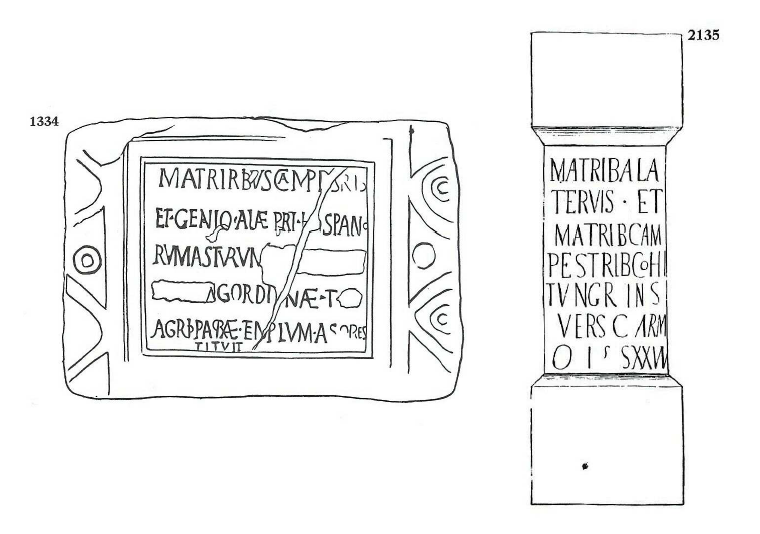E) The Campestres
Finally, the Matres took on a military aspect when equated with the Campestres, whose Latin name means ‘of the plain’. Associated with the campus, ‘parade-ground’, ‘battlefield’ or ‘encampment’, the Campestres were the Roman female genii of the army, military camps and the battlefield.566 They were held in veneration by mounted units and were thus, as Sylvia Barnard specifies, mothers who afforded protection for the cavalry on the battlefield.567 They were also believed to bring prosperity to towns and people.568 They had therefore a significant military aspect and were not simply ‘Mothers of the Countryside’, as Olmsted suggests.569
The Campestres are honoured on their own in various military inscriptions from Bökingen, Benningen (Germany), Rome (Italy), Gloster Hill near Warkworth (Northumbria), Newstead (Roxburghshire), Auchindary (Dunbarton)570 (GB) and the following at Castlehill (Antonine Wall): Campestribus et Britanni(ae) Q(uintus) Pisentius Iustus pr(a)ef(ectus) coh(ortis) IV Gal(lorum) v(otum) s(olvit) l(aetus) l(ibens) m(erito), ‘To the Goddesses of the Battlefield and Britannia, Quintus Pisentius Iustus, prefect* of the Fourth Cohort of Gauls, gladly, willingly, and deservedly fulfilled his vow’.571 The inscriptions show that the worship of the Campestres was confined to soldiers and Roman people.572 In Germany and Britain, the dedicators are indeed mostly soldiers of the Roman army, while in Rome they are generally Equites singulares, that is the Imperial Guard, composed of horsemen, who were recruited along the Rhine and the Danube.573 This of course enhances their military and classical character.574 Eric Birley, who studies and compares the various inscriptions to the Campestres in Rome and Britain, specifies that Marcus Cocceius Firmus, the dedicator of the dedication from Auchendavy, near Antonine Wall, had once served with the Equites singulares.575
In Britain, there are two dedications associating the Matres with the Roman Campestres. The first one was discovered in 1789 at Benwell (Northumbria): Matr(ibus) Tribus Campes[t]r[i]b(us) et Genio alae pri(mae) Hispanorum Asturum [Severianae Alexandrianae?] Gordianae T(erentius?) Agrippa prae(fectus) templum a so(lo) restituit, ‘To the Three Mother-Goddesses of the Battlefield and to the Genius of the First Cavalry Regiment of Asturian Spaniards styled […] Gordian’s Own, Terentius Agrippia, prefect*, restored this temple from round-level’ (fig. 28).576In the second inscription, excavated at Nether Cramond (Scotland) in 1697, the Matres Campestres are honoured along with the Matres Alatervae : Matrib(us) Alatervis et matrib(us) Campestrib(us) coh(ors) I Tungr(orum) ins(tante) VERSCARUM [c(enturione)] leg(ionis) XX V(aleriae) V(ictricis), ‘To the Mother-Goddesses Alatervae and the Mother-Goddesses of the Battlefield the First Cohort of the Tungrians (set this up) under the direction of […] the centurion of the Twentieth Legion Valeria Victrix’ (fig. 28).577

Through the interpretatio Romana, the names of the Matres and Matronae, like the other goddess names of the Celtic pantheon, were associated with Roman epithets or with the names of Roman goddesses, who had similar characteristics and functions to theirs. Like the indigenous Mother-Goddesses, the Junones, Parcae/Fatae, Nymphs, Proxsumae, Domesticaeand Campestres were indeed represented as multiple or collective female deities, as their names in the plural form indicate. Moreover, the depictions generally represent them as trios of goddesses, such as the Nymphs and the Proxsumae, for whom some iconographical devices have been discovered in Gaul. This of course establishes a connection to the Matres/Matronae, who are mainly portrayed as three in number on the numerous reliefs* found in Britain, Gaul and Germany. Finally, they were similar in their functions of fertility, fecundity and motherhood. Finally, all these Romanized goddesses protected the household, the family and women all through their life, as well as in the afterlife, which is why the Matres/Matronae were easily associated with these Roman epithets after the Roman invasion. It is clear that, in certain areas, such as in the south of Gaul, the names and cult of the Nymphs, Fatae and Junones completely replaced those of the indigenous Mother-Goddesses in Gallo-Roman times. Therefore, an important concentration of dedications to Roman female deities in a certain location could indicate an ancient cult of the Celtic Mothers. Such is very certainly the case of the Proxsumae, whose thirty-nine dedications are confined to the Rhône valley, and who were worshipped by a significant number of dedicators of Celtic origin.